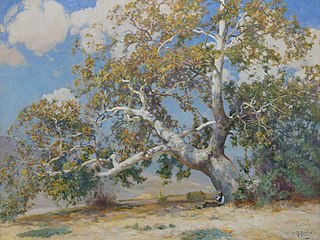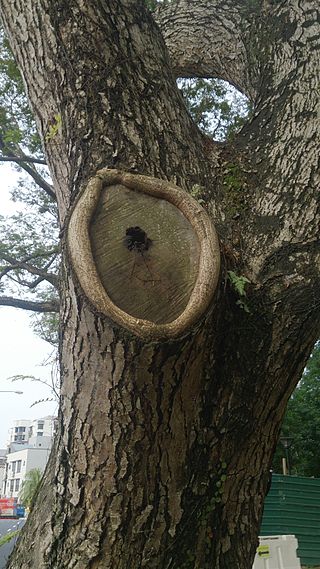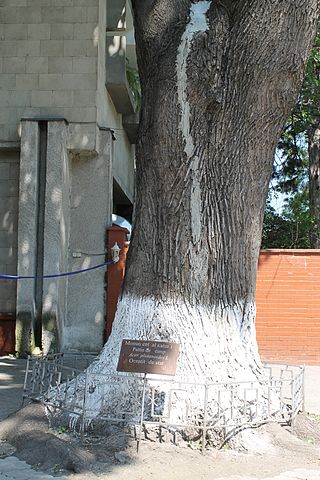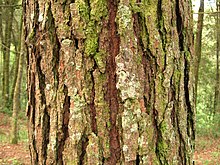
Bark is the outermost layer of stems and roots of woody plants. Plants with bark include trees, woody vines, and shrubs. Bark refers to all the tissues outside the vascular cambium and is a nontechnical term. It overlays the wood and consists of the inner bark and the outer bark. The inner bark, which in older stems is living tissue, includes the innermost layer of the periderm. The outer bark on older stems includes the dead tissue on the surface of the stems, along with parts of the outermost periderm and all the tissues on the outer side of the periderm. The outer bark on trees which lies external to the living periderm is also called the rhytidome.

The vascular cambium is the main growth tissue in the stems and roots of many plants, specifically in dicots such as buttercups and oak trees, gymnosperms such as pine trees, as well as in certain other vascular plants. It produces secondary xylem inwards, towards the pith, and secondary phloem outwards, towards the bark.

Cork cambium is a tissue found in many vascular plants as a part of the epidermis. It is one of the many layers of bark, between the cork and primary phloem. The cork cambium is a lateral meristem and is responsible for secondary growth that replaces the epidermis in roots and stems. It is found in woody and many herbaceous dicots, gymnosperms and some monocots. It is one of the plant's meristems – the series of tissues consisting of embryonic disk cells from which the plant grows. The function of cork cambium is to produce the cork, a tough protective material.

Platanus occidentalis, also known as American sycamore, American planetree, western plane, occidental plane, buttonwood, and water beech, is a species of Platanus native to the eastern and central United States, the mountains of northeastern Mexico, extreme southern Ontario, and extreme southern Quebec. It is usually called sycamore in North America, a name which can refer to other types of trees in other parts of the world. The American sycamore is a long-lived species, typically surviving at least 200 years and likely as long as 500–600 years.

Platanus racemosa is a species of plane tree known by several common names, including California sycamore, western sycamore, California plane tree, and in North American Spanish aliso. Platanus racemosa is native to California and Baja California, where it grows in riparian areas, canyons, floodplains, at springs and seeps, and along streams and rivers in several types of habitats. It can be found as far north as Tehama and Humboldt counties.

In botany, the trunk is the stem and main wooden axis of a tree, which is an important feature in tree identification, and which often differs markedly from the bottom of the trunk to the top, depending on the species.

A burl or burr is a tree growth in which the grain has grown in a deformed manner. It is commonly found in the form of a rounded outgrowth on a tree trunk or branch that is filled with small knots from dormant buds. Burl formation is typically a result of some form of stress such as an injury or a viral or fungal infection.

A plant canker is a small area of dead tissue, which grows slowly, often over years. Some cankers are of only minor consequence, but others are ultimately lethal and therefore can have major economic implications for agriculture and horticulture. Their causes include a wide range of organisms as fungi, bacteria, mycoplasmas and viruses. The majority of canker-causing organisms are bound to a unique host species or genus, but a few will attack other plants. Weather and animal damage can also cause stress to the plant resulting in cankers. Other causes of cankers is pruning when the bark is wet or using un-sterilized tools.

Girdling, also called ring-barking, is the circumferential removal or injury of the bark of a branch or trunk of a woody plant. Girdling prevents the tree from sending nutrients from its foliage to its roots, resulting in the death of the tree over time, and can also prevent flow of nutrients in the other direction depending on how much of the xylem is removed. A branch completely girdled will fail and when the main trunk of a tree is girdled, the entire tree will die, if it cannot regrow from above to bridge the wound. Human practices of girdling include forestry, horticulture, and vandalism. Foresters use the practice of girdling to thin forests. Extensive cankers caused by certain fungi, bacteria or viruses can girdle a trunk or limb. Animals such as rodents will girdle trees by feeding on outer bark, often during winter under snow. Girdling can also be caused by herbivorous mammals feeding on plant bark and by birds and insects, both of which can effectively girdle a tree by boring rows of adjacent holes.
A bridge graft is a grafting technique used to re-establish the supply of nutrients to the rootstock of a woody perennial when the full thickness of the bark has been removed from part of the trunk.
Tree topping is the practice of removing whole tops of trees or large branches and/or trunks from the tops of trees, leaving stubs or lateral branches that are too small to assume the role of a terminal leader. Other common names for the practice include hat-racking, heading, rounding over, and tipping. Some species of trees are more likely to recover from topping than others. There are alternatives to topping that can help to achieve the same goals without damaging trees.

Ophiognomonia clavigignenti-juglandacearum is a mitosporic fungus that causes the butternut canker, a lethal disease of butternut trees. It is also known to parasitize other members of the genus Juglans on occasion, and very rarely other related trees including hickories. The fungus is found throughout North America, occurring on up to 91% of butternut trees, and may be threatening the viability of butternut as a species.

A branch collar is the "shoulder" between the branch and trunk of woody plants; the inflammation formed at the base of the branch is caused by annually overlapping trunk tissue. The shape of the branch collar is due to two separate growth patterns, initially the branch grows basipetally, followed by seasonal trunk growth which envelops the branch.
Eutypella canker is a plant disease caused by the fungal pathogen Eutypella parasitica. This disease is capable of infecting many species of maple trees and produces a large, distinguishable canker on the main trunk of the tree. Infection and spread of the disease is accomplished with the release of ascospores from perithecia. Therefore, the best way to manage the Eutypella canker is to remove trees that have been infected. If infected, it can decrease the quality of wood cut for lumber and can thus have a negative economic impact.

Carya laciniosa, the shellbark hickory, in the Juglandaceae or walnut family is also called kingnut, big, bottom, thick, or western shellbark, attesting to some of its characteristics. It is a slow-growing, long-lived tree, hard to transplant because of its long taproot, and subject to insect damage. The nuts, largest of all hickory nuts, are sweet and edible. Wildlife and people harvest most of them; those remaining produce seedling trees readily. The wood is hard, heavy, strong, and very flexible, making it a favored wood for tool handles. A specimen tree has been reported in Missouri with 117 cm (46 in) diameter at breast height, 36.9 m tall, and a spread of 22.6 m.

Tree paint, also known as wound dressing, is any substance applied to damaged surfaces of a tree intended to improve its health. It is commonly applied after pruning, or at locations where the tree bark has been damaged.

Sun scald is the freezing of bark following high temperatures in the winter season, resulting in permanent visible damage to bark. Fruits may also be damaged. In the northern hemisphere, it is also called southwest injury.

A stem is one of two main structural axes of a vascular plant, the other being the root. It supports leaves, flowers and fruits, transports water and dissolved substances between the roots and the shoots in the xylem and phloem, photosynthesis takes place here, stores nutrients, and produces new living tissue. The stem can also be called halm or haulm or culms.

Thousand cankers disease (TCD) is a recently recognized disease of certain walnuts. The disease results from the combined activity of the walnut twig beetle and a canker producing fungus, Geosmithia morbida. Until July 2010 the disease was only known to the western United States where over the past decade it has been involved in several large scale die-offs of walnut, particularly black walnut, Juglans nigra. However, in late July 2010 a well-established outbreak of the disease was found in the Knoxville, Tennessee, area. This new finding is the first locating it within the native range of its susceptible host, black walnut. In 2013, an outbreak was found in the Veneto region of Italy, where the disease has been found on both black walnut and English walnut.
Leucostoma canker is a fungal disease that can kill stone fruit. The disease is caused by the plant pathogens Leucostoma persoonii and Leucostoma cinctum (teleomorph) and Cytospora leucostoma and Cytospora cincta (anamorphs). The disease can have a variety of signs and symptoms depending on the part of the tree infected. One of the most lethal symptoms of the disease are the Leucostoma cankers. The severity of the Leucostoma cankers is dependent on the part of the plant infected. The fungus infects through injured, dying or dead tissues of the trees. Disease management can consist of cultural management practices such as pruning, late season fertilizers or chemical management through measures such as insect control. Leucostoma canker of stone fruit can cause significant economic losses due to reduced fruit production or disease management practices. It is one of the most important diseases of stone fruit tree all over the world.























